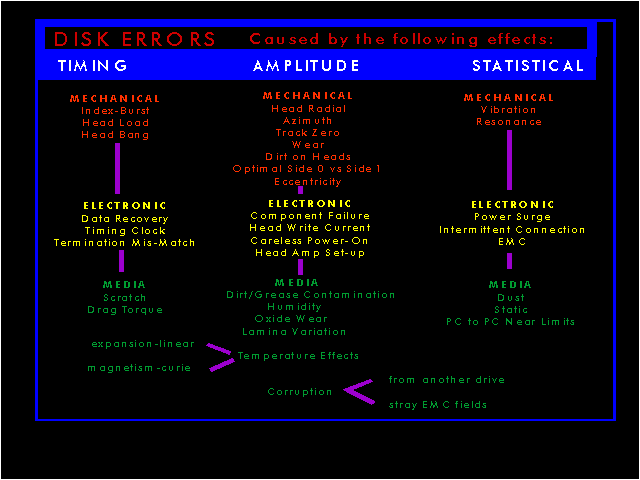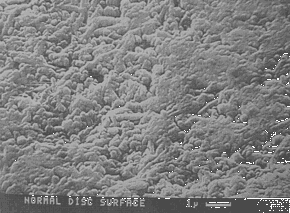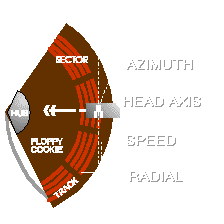| Floppy Drives today are very reliable but can suffer from poor alignment and head contamination as do VCRs or any other technology that uses heads in accurate contact with moving magnetic media.
There used to be many problems with earlier drives that have now been either ironed out by using better technology, or are too expensive to repair and therefore it is cheaper to replace the drive unit completely.
|
| The following chart shows the failure mechanisms (click on it to see a larger version): |
 |
COMMON PROBLEMS
Fortunately today, the most common problem is either "Radial Alignment" or "Dirty Heads".
HEAD CONTAMINATION |
This is a picture of a floppy drive head taken using an electron microscope. |
| Similarly to Video and Audio Recorders and Tape Back-ups, the heads of the floppy drive can and do become contaminated with usage. |
Typical floppy disk media (close up of a cookie) |
| The failure mechanism is usually loose oxide dust on the media (disk surface) being rubbed onto the heads. The heads are always in
contact with the magnetic surface (unlike Hard Disks where they "float") and the false economy of using low cost media is often to blame.
|
| Another little known fact is that the fan used to cool typical PC's is blowing the wrong way round ! Seriously, try it! |
| Place your hand on the back of a PC and you will note that the air flow is out of the case. This means that air is not blowing onto the processor chip directly, but more seriously any airborne contamination is sucked into the case usually via the slot in the disk drive !
This constant flow of unfiltered air can deposit dust and other perspirative and aromatic contaminants onto the heads as it blows past.
|
Regular cleaning of the heads will give reliable operation and also prevent dirty heads contaminating other floppy media !

|
| RADIAL is the loss of head signal due to the heads not being exactly on centre of track. On most drives this can be brought back into alignment by using HeadmaX
in real-time mode. A simple screw adjustment of the stepper motor assembly is usually all that is required.
|
| ROTATIONAL SPEED
This is the actual rotating speed of the disk. Too fast and data "overwrites", too slow and synchronisation is lost. The overall picture is a little more
complex than this but for the benefit of this web page, this explanation should suffice.
Some earlier drives that were servo-driven, could be adjusted with a variable pot (in effect, small adjustable electronic screw).
Nearly all drives today are crystal controlled and no adjustment is possible. Not often a problem but if it is it's usually zero rotational speed !
|
| AZIMUTH
This is the skew that is off centre-line of the actual heads. Heads at an angle from "true" mean reduced signal strength. HeadmaX can actually read this
analogue head signal level and if the Radial Alignment is OK as well as clean heads, then a low signal is indicative of poor Azimuth.
Unfortunately not much can be done to cure this even by the most technical user on modern drives; fortunately though, this condition is rare.
It can be caused by severe jolting of the drive during transport or sometimes by poorly aligned head assemblies.
The two heads at either side of the cookie can squeeze and distort the disk if they are not exactly in line. This has the same end effect as Azimuth does.
|